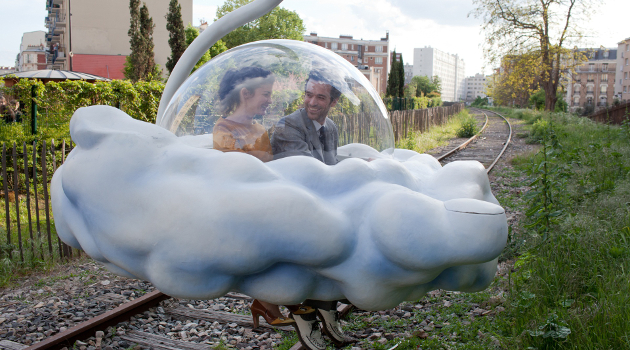
Written by Michel Gondry and Luc Bossi
Directed by Michel Gondry
France/Belgium, 2013
Adapted from Boris Vian’s cult novel, commonly translated as Froth on the Daydream, Michel Gondry’s latest film is a riotous, whimsical journey with a lot more to say than initially meets the eye. The opening sequence threatens to drown you in a cavalcade of offbeat animation and special effects, including a stop motion eel, an insect-like doorbell, a TV chef who passes ingredients through the screen and a miniature man dressed up like a mouse. Gondry’s indulgence throws down the gauntlet right away – either you’re in or you’re out. Mood Indigo can be bewildering, exasperating, infuriating, but, then again, it can be utterly transportive.
It stars Romain Duris as Colin, a wealthy bachelor who lives in a luxurious Parisian apartment with his cook/lawyer/intellectual guide Nicolas (Omar Sy). He has far too much money to even think about working and instead spends his time going to high class parties and inventing charming devices like the pianocktail, a piano that mixes cocktails according to the music that is played. Life is good and can only get better. All that is missing is love, but, like everything else, that comes easily. When his friend Chick (Gad Elmaleh) announces that he has met a girl, Alise (Aïssa Maïga), Colin demands that he falls in love as well. And, in about five minutes of screen time, he does.
It comes in the form of Chloé, a beautiful young woman who shares his eccentric sense of humour, inevitably played by Audrey Tautou. After dancing the biglemoi, a jazzy dance featuring preposterously stretched limbs, they take a tour of Paris on a mechanical cloud and kiss for the first time in an underground garden. Before long, they are ecstatically married but cracks begin to appear when Chloé falls ill. She is diagnosed with a water lily growing in her lung and the only cure is to surround her with flowers until it dies. Burdened with having to pay for her expensive treatment, Colin is forced to take a series of demeaning jobs and an oppressive gloom starts to dominate their world.

Mood Indigo’s first act is so infectious and intoxicating that you forget there must be another side to the life it depicts. Gondry sets up a childlike universe with a perpetual sense of joie de vivre. When dirty plates are smashed at the end of a meal, they clean and repair themselves; when the doorbell is stamped on, it picks itself up and scuttles back to the wall. There is no work, no pain, no responsibility – it seems as though nothing could ever go wrong. When Colin and Chloé visit the countryside for their honeymoon, the screen divides in two, each side showing markedly different weather. Bright sunshine or torrential rain; it is theirs to choose; life is a game.
There are hints throughout the film that all is not quite as it seems, but you choose to ignore them. Behind the excess and frivolity, there are suggestions of inequality, servitude and brutality, but while the daydream lasts, they seem quaint and unreal. Chick is obsessed with the intellectual writings of Jean-Sol Partre, dedicating all his time and money to obtaining rare copies of his books. He is not the only one either. There is a national cult surrounding Partre; he is an icon, an oppressive idol. Assuming you catch the obvious spoonerism, his prominence implies the nausea that exists as a counterpoint to the whimsy.

Gondry handles the transition between these perspectives majestically, demonstrating almost megalomaniacal control over the film’s tone. He even makes an appearance himself, fittingly playing the doctor who instigates Chloé’s demise. In the second half of Mood Indigo, the joyous energy and vibrant colours gradually fade to monochrome, while Colin’s apartment shrinks down and the light gets obscured by cobwebs. Colin’s jobs, one of which involves using the warmth from his body to create weapons, seem to serve a violent, dystopian bureaucracy and it becomes clear that the lifestyle he used to enjoy implicitly endorsed it. The film can be taken as a damning indictment of blind, unbridled privilege, although you get the impression that Gondry is aiming higher, railing against reality itself.
One motif that is central to the film is a conveyor belt of typewriters, with people writing out the lives of everyone in it. However, they only get a few seconds to type each statement before it moves on, meaning they have no chance to become invested in their characters’ lives. It is simply a way of controlling their narrative. As the film goes on, we realise that Colin and Chloé are not really the focus – their story is not especially unique and has been told before innumerable times in considerably greater depth. Instead, Mood Indigo is about life in all its possibilities, the way it springs into being, crumbles or fades away, its fragility and the lack of agency we have over its permutations.
More than any of his other films, this is Gondry’s own, Gondry’s world. His visual flair, favouring animation and mechanical effects over CGI, has never been better or more dominant, and the result comes very close to matching the emotional power and bittersweet sensibility of Eternal Sunshine of the Spotless Mind. Gondry is wonderfully unrestrained and has made a film of unquestionable ambition, joy and heartbreak that easily transcends its superficial flaws.
Visit the 2014 Glasgow Film Festival’s official website here.

